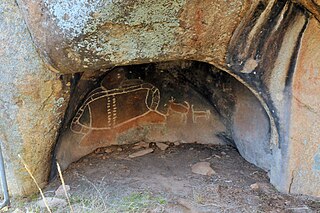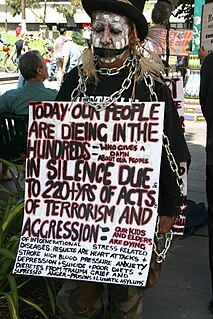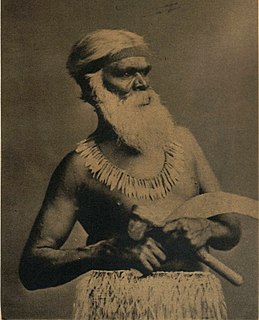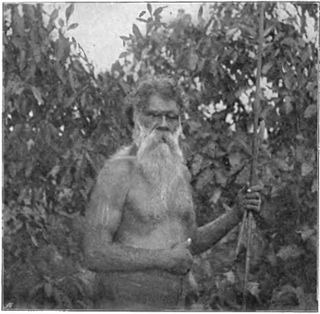 W
WAboriginal Victorians, the Aboriginal Australians of Victoria, Australia, occupied the land for tens of thousands of years prior to European settlement. Aboriginal people have lived a semi-nomadic existence of fishing, hunting and gathering, and farming eels in Victoria for at least 40,000 years.
 W
WThe Barapa Barapa people are an indigenous Australian people whose territory covered parts of southern New South Wales and northern Victoria. They had close connections with the Wemba-Wemba.
 W
WThe Bidhawal were an Australian Aboriginal tribe of Gippsland, Victoria. According to Alfred William Howitt, the Bidhawal were composed of "refugees from tribes".
 W
WBunjil is a creator deity, culture hero and ancestral being, often depicted as a wedge-tailed eagle in the Australian Aboriginal mythology of some of the Aboriginal peoples of Victoria.
 W
WDjadjawurrung or Dja Dja Wurrung, also known as the Jaara or Jajowrong people and Loddon River tribe, is an Aboriginal Australian people whose traditional lands include the watersheds of the Loddon and Avoca rivers in the Bendigo region of central Victoria, Australia. They are part of the Kulin alliance of Aboriginal Victorian peoples. There are 16 clans, which adhere to a patrilineal system. Like other Kulin peoples, there are two moieties: Bunjil the eagle and Waa the crow.
 W
WThe Gadubanud (Katubanut) also known as the Pallidurgbarran or Yarro waetch, were an Aboriginal Australian people of the state of Victoria. Their territory encompassed the rainforest plateau and rugged coastline of Cape Otway. They are thought to have become extinct quickly following the onset of white colonisation, and little is known of them. Some may have found refuge at the Wesleyan mission station at Birregurra and later the Framlingham mission station, and some people still trace their descent from such a remnant. Today, by the principle of succession, the Gunditjmara are considered the traditional custodians of Gadubanud lands.
 W
WThe Girai wurrung, also spelt Kirrae Wuurong and Kirrae Whurrung, are an Aboriginal Australian people who traditionally occupied the territory between Mount Emu Creek and the Hopkins River up to Mount Hamilton, and the Western Otways from the Gellibrand River to the Hopkins River. The historian Ian D. Clark has reclassified much of the material regarding them in Norman Tindale's compendium under the Djargurd Wurrung, a term reflecting the assumed pre-eminence of one of their clans, the Jacoort/Djargurd.
 W
WJarijari were an indigenous Australian people whose traditional territory was located in the Mallee region of Victoria.
 W
WKoori is a demonym for Aboriginal Australians from the approximate region now known as New South Wales and Victoria. The word derives from the Indigenous language Awabakal. For some people and groups, it has been described as a reclaiming of Indigenous language and culture, as opposed to relying on European titles such as "Aboriginal". The term is also used with reference to institutions involving Koori communities and individuals, such as the Koori Court, Koori Radio and Koori Knockout.
 W
WThe Krauatungalung are an Indigenous Australian people, of East Gippsland, in the state of Victoria, Australia. They are regarded as a group of the Kurnai, though Tindale states that their inclusion as one of the Gunai is artificial.
 W
WThe Kulin nation is an alliance of five Indigenous Australian nations in south central Victoria, Australia. Their collective territory extends around Port Phillip and Western Port, up into the Great Dividing Range and the Loddon and Goulburn River valleys.
 W
WThe Ngarigo are an Aboriginal Australian people of southeast New South Wales, whose traditional lands also extend around the present border with Victoria.
 W
WNgooraialum were an indigenous Australian tribal subgroup, one of 3 comprising the Ngurai-illam-wurrung, though Norman Tindale placed them among the Taungurong. They inhabited land along the Goulburn River in central Victoria, north of Mitchellstown, at Murchison, above Toolamba, within 40 miles (64 km) of the Murray-Goldburn junction. The heart of their land was Noorillim, which they called Waaring.
 W
WThe Dadi Dadi or Tatitati are an Australian Aboriginal tribe whose traditional lands are located along the southern banks of the Murray River in Victoria Australia.
 W
WThe Taungurong people, also known as the Daung Wurrung, were thirteen clans who spoke the Daungwurrung language and were part of the Kulin alliance of indigenous Australians. They lived to the north of, and were closely associated with, the Woiwurrung speaking Wurundjeri people. Their territory was to the north of the Great Dividing Range in the watersheds of the Broken, Delatite, Coliban, Goulburn and Campaspe Rivers. They were also known by white settlers as the Devil's River Tribe or Goulburn River Tribe.
 W
WThe Warkawarka, also called Weki Weki, were an Australian Aboriginal group whose traditional lands are located in Victoria, Australia. Controversy exists as to whether they were an independent 'tribe' or rather consisted of a subgroup of the Wergaia, the latter view being shared by both Robert M. W. Dixon and Luise Hercus.
 W
WThe Wemba-Wemba are an Aboriginal Australian group in north-Western Victoria and south-western New South Wales, Australia, including in the Mallee and the Riverina regions. They are also known as the Wamba-Wamba.
 W
WThe Woiwurrung, also spelt Woi Wurrung, Woiwurrong, Woiworung, Wuywurung, are an Aboriginal Australian people of the Woiwurrung language group, in the Kulin alliance.
 W
WThe Wurundjeri are an Aboriginal Australian nation of the Woiwurrung language group, in the Kulin alliance. They occupied the Birrarung Valley before British colonisation of the area, around the present location of Melbourne.
 W
WThe Yorta Yorta, also known as Jotijota, are an Aboriginal Australian people who have traditionally inhabited the area surrounding the junction of the Goulburn and Murray Rivers in present-day north-eastern Victoria and southern New South Wales.